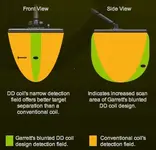If you are able correctly to understand VERY LONG

machine translation. I can quote one post on this subject from a Russian-speaking forum. This message seems to me very full.
Quote beginning
For beginners about Mono and DD coils
ice message" 09 Feb 2010, 15:37:41
Let's try to consider in general these two types of coils for acquaintance
In the theory a difference between mono and DD as you understand in construct and tactics technical characteristics. at mono coils the beam goes a cone from all plane, and at DD as though an edge through its center, from here...
Mono pluses in comparison with DD:
It is more than depth at cone peak, that is 10" mono coils on the center takes just as bigger 12" DD, but to edges of the coil depth at Mono sharply falls
Better purpose identification, that is any party to the purpose the will be identical. But we won't forget that if the purpose masking by ferrous metal, it is necessary to scan it from all directions, it isn't dependent on coil type
Better purpose centering at detection of exact location of a find
The DD pluses in comparison with Mono:
Stable depth on all length of the coil, that is it is more stable - the productive area of scanning, it is less than admissions
Stabler work and depth on the mineralized soil
General minus Mono and DD:
At increase in the size of the coil more than about 14 inches start worsening identification and sensitivity to the small purposes, coil unstable work raises
It everything in the theory, well and in practice we have full mess connected most likely with the concept "successful model" and "not successful model" of the coil of a line of firm of the producer. On this practician and responses of colleagues you shouldn't ignore, but also laws of physics who didn't cancel
I will try to bring the IMHO:
for search on the platforms littered by iron it is better to choose small 6" the Mono coil
for investigation and primary search on a platform it is necessary 10DD or 12 of DD
for a deep doborka (hunting behind that remained from those who was earlier) of the empire on rather pure place it is necessary big Mono or DD, the size from 12 inches to 15”
If you don't dig on war, be not fond of big "wheels"
As there is a distinction of coils in a form - round and an ellipse. Ellipse it is more convenient on a dense grass, in a bush, between trees. In certain cases smaller number of the purposes in coil capture
Well here in brief something like this, certainly there are many subtleties in certain conditions of search and personal preferences, for example in a postscoring, play not the last role, but I think that I described the general rules. If is what to add - that guys will add me
The detector X-Terra 705 can function
on various transmission frequencies with coils,
compatible to the VFLEX technology.
Concentric standard frequency (7.5 kHz)
This frequency is suitable for search more
main objectives on the main types of the soil. On
these the coil is available a sticker of M.
Concentric Low frequency (3kHz)
This frequency is suitable for search more
the large purposes at a bigger depth, and coins with
high conductivity (majority of coins
The USA), such coils reject signals better
from ferrous metals. On them there is a sticker
L.
Concentric High frequency (18.75 kHz)
This frequency is suitable for search more
the small purposes at a surface, gold
nuggets and the purposes with low conductivity
(stamping coins, small jewelry). On
these the coil is available H sticker
Double D (7.5 kHz and 18.75 KHZ)
By means of these coils the detector is better
adjusts balance of soil. They it is ideal
are suitable for search of gold nuggets in
to the the strongly mineralized soil or on
beaches with magnetitovy sand
Quote end
If something isn't clear - please ask




 machine translation. I can quote one post on this subject from a Russian-speaking forum. This message seems to me very full.
machine translation. I can quote one post on this subject from a Russian-speaking forum. This message seems to me very full.